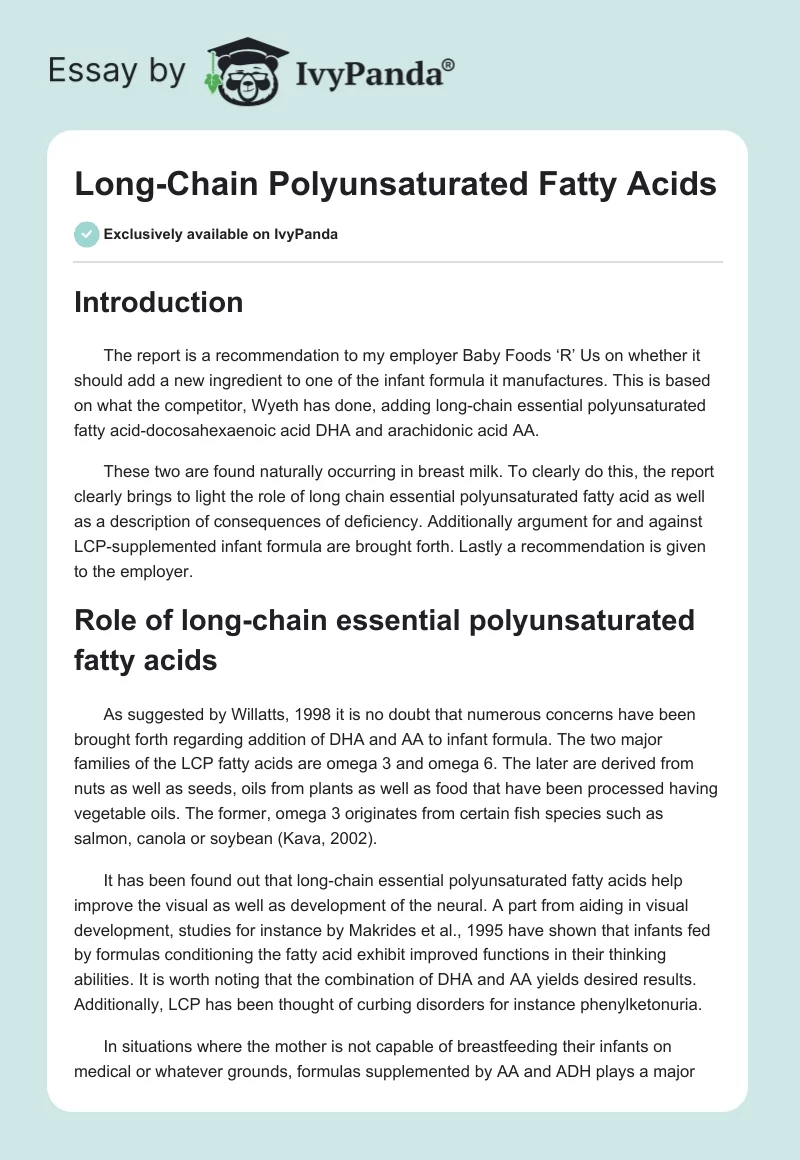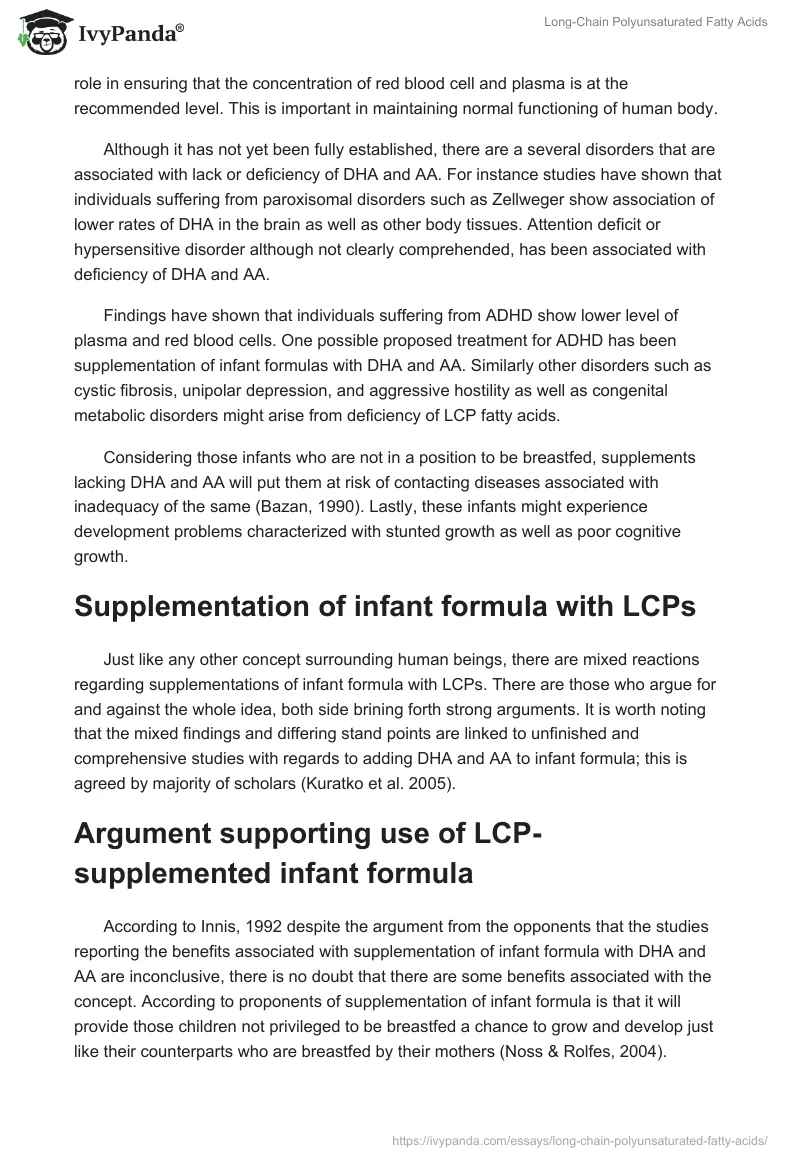Introduction
The report is a recommendation to my employer Baby Foods ‘R’ Us on whether it should add a new ingredient to one of the infant formula it manufactures. This is based on what the competitor, Wyeth has done, adding long-chain essential polyunsaturated fatty acid-docosahexaenoic acid DHA and arachidonic acid AA.
These two are found naturally occurring in breast milk. To clearly do this, the report clearly brings to light the role of long chain essential polyunsaturated fatty acid as well as a description of consequences of deficiency. Additionally argument for and against LCP-supplemented infant formula are brought forth. Lastly a recommendation is given to the employer.
Role of long-chain essential polyunsaturated fatty acids
As suggested by Willatts, 1998 it is no doubt that numerous concerns have been brought forth regarding addition of DHA and AA to infant formula. The two major families of the LCP fatty acids are omega 3 and omega 6. The later are derived from nuts as well as seeds, oils from plants as well as food that have been processed having vegetable oils. The former, omega 3 originates from certain fish species such as salmon, canola or soybean (Kava, 2002).
It has been found out that long-chain essential polyunsaturated fatty acids help improve the visual as well as development of the neural. A part from aiding in visual development, studies for instance by Makrides et al., 1995 have shown that infants fed by formulas conditioning the fatty acid exhibit improved functions in their thinking abilities. It is worth noting that the combination of DHA and AA yields desired results. Additionally, LCP has been thought of curbing disorders for instance phenylketonuria.
In situations where the mother is not capable of breastfeeding their infants on medical or whatever grounds, formulas supplemented by AA and ADH plays a major role in ensuring that the concentration of red blood cell and plasma is at the recommended level. This is important in maintaining normal functioning of human body.
Although it has not yet been fully established, there are a several disorders that are associated with lack or deficiency of DHA and AA. For instance studies have shown that individuals suffering from paroxisomal disorders such as Zellweger show association of lower rates of DHA in the brain as well as other body tissues. Attention deficit or hypersensitive disorder although not clearly comprehended, has been associated with deficiency of DHA and AA.
Findings have shown that individuals suffering from ADHD show lower level of plasma and red blood cells. One possible proposed treatment for ADHD has been supplementation of infant formulas with DHA and AA. Similarly other disorders such as cystic fibrosis, unipolar depression, and aggressive hostility as well as congenital metabolic disorders might arise from deficiency of LCP fatty acids.
Considering those infants who are not in a position to be breastfed, supplements lacking DHA and AA will put them at risk of contacting diseases associated with inadequacy of the same (Bazan, 1990). Lastly, these infants might experience development problems characterized with stunted growth as well as poor cognitive growth.
Supplementation of infant formula with LCPs
Just like any other concept surrounding human beings, there are mixed reactions regarding supplementations of infant formula with LCPs. There are those who argue for and against the whole idea, both side brining forth strong arguments. It is worth noting that the mixed findings and differing stand points are linked to unfinished and comprehensive studies with regards to adding DHA and AA to infant formula; this is agreed by majority of scholars (Kuratko et al. 2005).
Argument supporting use of LCP-supplemented infant formula
According to Innis, 1992 despite the argument from the opponents that the studies reporting the benefits associated with supplementation of infant formula with DHA and AA are inconclusive, there is no doubt that there are some benefits associated with the concept. According to proponents of supplementation of infant formula is that it will provide those children not privileged to be breastfed a chance to grow and develop just like their counterparts who are breastfed by their mothers (Noss & Rolfes, 2004).
Additionally results from a number of randomized control trials have shown although not comprehensively that adding LCPs to infant formula will help provide therapeutic benefits to individuals suffering from mental disorders. This is one argument brought forth by supporters of the idea of adding LCPs to infant formula that has generated research interests.
Interestingly, it has been argued that a substantial amount of premature birth as well as lower weights at birth of infant is linked to mothers lacking adequate DHA. In order to counter this, there is need to augment infant formula with LCPs so that once they are productive they give birth to healthy kids (Simopoulos, 1999).
Additionally, adding DHA and AA has been thought to be vital in development of cognitive as well as improved visual capabilities. On the same note, adequate quantities of LCPs especially DHA and AA play a significant role in preventing health conditions such as heart diseases, CF, mental illnesses, as well as poor vision.
Based on the fact that there is no single study that has established that addition of AA and DHA in infant formula pose health risks to infants, those supporting supplementation put this forth as supporting argument. To them there is no reason of blocking addition as long as it poses no health hazard to users (Birch et al. 2002).
Argument against use of LCP-supplemented infant formula
As noted previously, there is no study that has proved LCPs to be of health concern. Based on this there is an argument that similarly since there is no research study that has proved beyond doubt that addition of DHA and AA is safe warrants opposition of the whole idea. Additionally, there are a number of studies such as Makrides et al., 1995 found no significance difference in head circumference, weight and length between LCPs treated infants and their controlled counterparts.
For opponents, if there is no improvement brought about by addition of DHA and AA in infant formula then it is better for it not to be done. Interestingly, those on the other side supporting supplementation of infant formula with LCPs acknowledge that studies supporting the purported benefits associated with such an initiative are not conclusive (Noss & Rolfes, 2004). For that reason, oppossers are of the view that there is need to fully carryout extensive studies in order for the relevant stakeholders to be fully aware of the clinical implication of the idea (Simopoulos, 1999).
On the same regards, it has been established that infant formula supplemented with DHA may have potential impact of slowing infant growth making them stunted. A study on preterm infants found out that when fed with fish oil, there were chances of slowed growth. Lastly, a serious concerned raised in opposing adding DHA and AA supplement to infant formula is that some sources of the fatty acids such as fungi as well as algae are new and not fully proved hence not having a long history of safety (Willatts,1998).
Conclusion and recommendations
From the review of the concept of Supplementation of infant formula with LCPs, it is apparent that the benefits associated with the concept seem to outweigh arguments brought forth against the whole idea. However, having in mind that the concept is new having basic science but lacking long-term clinical impact I would advice my employer not to add DHA and AA in infant formula the company is producing.
There is need to carry out more research especially in trying to establish whether adding LCPs helps in situations where mothers’ milk lack the desired nutritional values. Additionally, more studies need to be carried to clearly establish the relationship between LCPs and the various deficit disorders deemed linked to it.
References
Bazan, N. (1990). Supply of n-3 polyunsaturated fatty acids and their significance in the central nervous system: Nutrition and the brain. New York: Raven Press.
Birch, E., et al. (2002). “Randomized control trial of long-chain polyunsaturated fatty acid supplementation of formula in terms infant after weaning at 6 weeks of age”. America Journal of Clinical Nutrition, 75(1): 570-580.
Innis, S. (1992) “Human milk and formula fatty acids. Journal of Pediatric, 120(3): 56–61.
Kava, R. (2002). “Long-chain polyunsaturated fatty acid supplementation of infant formula”. Web.
Kuratko, C. et al. (2005). “Importance of arachidonic acid in long-chain polyunsaturated fatty acid–supplemented infant formula.” American Journal of Clinical Nutrition, 82(6): 1353-1354.
Makrides, M. et al., (1995). “Erythrocyte fatty acids of term infants fed either breast milk, standard formula, or formula supplemented with long-chain polyunsaturates, Lipids”. America Journal of Clinical Nutrition, 30(1): 941-948.
Noss, E & Rolfes, R. (2004). Understanding nutrition. New York: Wadsworth Publishing.
Simopoulos, A. (1999). “Essentiality of and recommended dietary intakes for omega-6 and omega-3 fatty acids”. Ann Nutr Metab, 43(12):127-130.
Willatts, P. (1998). “Long-chain polyunsaturated fatty acids supplementation associated with infant intelligence”. Lancet, 352(23):688-691.


